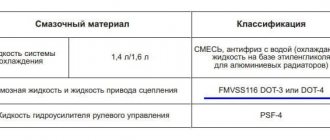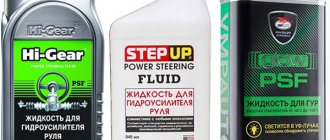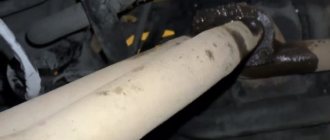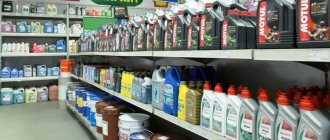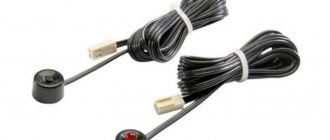Brake fluid with different bases are incompatible with each other, they separate, and sometimes sediment appears. The parameters of this mixture will be lower than those of any of the original liquids, and its effect on rubber parts is unpredictable. The manufacturer usually indicates the basis of the TJ on the packaging. Russian Ros DOT, “Neva”, “Tom”, as well as other domestic and imported polygonal liquids DOT3, DOT 4 and DOT 5.1, can be mixed in any proportions. TJ class DOT 5 are based on silicone and are incompatible with others. Therefore, the FM VSS 116 standard requires that “silicone” liquids be painted dark red. The remaining modern TJs are usually yellow (shades from light yellow to light brown). For additional testing, you can mix the liquids in a 1:1 ratio in a glass container. If the mixture is transparent and there is no sediment, the liquid liquids are compatible. It should be remembered that mixing liquids of different classes and manufacturers is not recommended, as their properties may change. It is forbidden to mix glycol fluids with castor fluids.
5.3 Marketing retreat
DOT 3, DOT 4 and DOT 5.1 fluids are hygroscopic, meaning that they absorb moisture from the air. The presence of moisture in the fluid lowers its boiling point; the operating temperature of the brake disc and pads usually exceeds it. That is why the boiling point of dry and moisture-containing fluid is indicated. The boiling point of wet fluid is measured at a moisture content of 3.5% Hygroscopicity is the reason for the need to replace brake fluid at least once every two years. The friction material on the brake pad serves to insulate the caliper from the heat generated by the disc, which is a very important reason to replace the pads long before they wear out. DOT5 liquid is not hygroscopic and does not mix with water. When water enters the system, it sinks down and is located near the hottest area of the system. This means that it will boil very easily and quickly, forming gas bubbles that are easily compressed, which in turn gives the brakes a springy feel. Another problem with DOT 5 is that the liquid itself becomes compressible as it approaches boiling point; This leads to a feeling of elasticity in the brakes with frequent and prolonged use.
Today in our market you can find many imported brake fluids (Brake Fluid). If such a fluid is recommended by the manufacturer for any car and is marked DOT-3 or DOT-4, then it can be used equally in foreign cars and domestic cars. It can also be argued that the composition of this product includes various esters, low molecular weight polymers and targeted additives. As for performance qualities (including temperature properties), when compared in the corresponding class (DOT-3 or DOT-4), imported liquids are approximately identical to our “Tom” or “Rosa” and do not have any special differences from them.
Imported drugs are widely represented on the market. When choosing, the main criterion is compliance with the requirements of the DOT class recommended for a particular vehicle (for NivaDOT-4).
In my opinion, using imported fluids in Niva makes little sense. Corrosion of the brake system is more active from the outside, and the remaining properties are identical to Rosa.
And finally, for the most curious, some car companies use brake fluids based on mineral oil. They are not hygroscopic, do not provoke corrosion and last longer than their counterparts with glycol starter. They are very rare and expensive.
Didn't find what you were looking for? Use the search:
Modern brake fluids are quite technologically advanced; they can withstand high temperatures, as well as high pressure in the brake system of a modern car. They are not compressible and therefore they are used in the braking system of a car, that is, compressing, like gas or air, cannot be done. That is why the car’s system is liquid; it has proven its reliability (in fairness, it is worth noting that there are also pneumatic options). BUT, the hydraulic option still has some minor drawbacks - it can leak, for example, if the brake hose breaks, but you still need to drive! But what to do if you don’t have exactly the same composition as you (the original was filled in from the dealer)? Then a fair question arises - is it possible to mix brake fluid from different manufacturers and different classes, say, pour DOT3 into DOT4 - what will happen? As usual, the article will be extensive + video version at the end, so read and watch...
Dry and wet mixture
At the very beginning, I would like to talk about the hygroscopicity of brake fluid (for those who don’t know, this is the ability to absorb moisture from the environment). That is why it must be changed after a certain period of time, on average every 2 - 4 years, it all depends on the class (more on this below).
So, when you have just opened a sealed jar (which has not had contact with the surrounding air), and want to pour it into the main tank, then this composition will be called DRY , because there is no moisture there at all! After all, it just opened.
But if your car or open can was in contact with air (the can may have been lying open on a shelf for a couple of years). The liquid has already absorbed a large percentage of moisture! Moreover, only 3.5% is enough so that it can no longer be used in the braking system! This mixture is called MOISTURIZED (it simply contains water)!
Russian analogues
Let's look at the Russian analogues for Neva and Tom brakes, and whether they can be mixed with each other and with derivatives of the DOT classification:
- Neva, familiar to many, is produced on the basis of glycol with polyester. It also contains an anti-rust additive. However, the disadvantage is the rapid accumulation of water in it (hygroscopicity), which reduces its characteristics and requires more frequent replacements than others, is considered obsolete, and is gradually going out of production.
- Tom liquid contains glycol ether and a set of additives. Its performance is higher than that of Neva. In terms of quality and composition, it meets the DOT-3 class.
- The same base allows you to mix them with each other, replace the Neva with Tom. In addition, Tom can be mixed with other liquids of the dot-3 class and higher that have a glycol base.
- But can Neva be mixed with Dot 4? It is possible, this has been tested by experience and in practice by many motorists. Only this mixture, due to the fault of the Neva, requires more frequent changes, reducing the time by almost half. Agree, it will be cheaper to completely replace the Neva with a more reliable and long-term analogue.
DOT classification
To begin with, what is DOT anyway? If you decipher it, it turns out that the Department Of Transportation (Or Department of Transport) is located in the jurisdiction of the United States. So this department decided to distinguish between different compositions by class - as a result, DOT1 appeared, and then others.
DOT1 - DOT2 - these are the very first brake fluids, they were based on mineral substances, now they are practically not used, so we won’t bother with them, although I will note them for general development. They were used on low-speed vehicles, speeds up to approximately 40 - 60 km/h, and under heavy loads they could boil quite quickly. As a result, they very quickly lost their characteristics.
Now a small remark - ask, why could it boil? Yes, everything is simple: when the car slows down, and the slope is prolonged, the wheel rims can heat up to 350 - 400 degrees Celsius. Part of the heat is transferred to the calipers, and from them to the brake fluid itself. The mineral started to boil already at 140 degrees.
DOT3 is the third class, it was kind of innovative. It already contained a glycolic base. The boiling point of a dry liquid is 230, and a moistened one is 140 degrees .
DOT4 is the fourth class, believe it or not, the third was not enough, especially in a state of moisture. The base is again glycols. The compositions have been slightly modified, and now the characteristics are 240 and 155, respectively . It is worth noting that for most passenger cars at the moment this is enough, but there are cars with powerful engines, heavy bodies and exorbitant speeds.
DOT5.1 is the next class for them (you’ll understand why with the dot later). There is also a glycol component in the base. BUT the temperature threshold is again increased to 260 and 180 degrees actually . However, these compounds are much more expensive, so they are rarely used on budget cars.
How do you understand this, so to speak – the “glycol branch” of development. Such compositions have many advantages, because we need not only boiling, but also lubrication on the inside - these are pistons, seals, cylinders, etc. (it should be noted that seals with glycols work very well and for a long time). Also, these brake fluids are quite stable. That is, they do not have any deviations in characteristics.
The downside is that it needs to be replaced every 2-3 years, because the hygroscopicity is at a very high level. It should be noted that this is a really “fat” minus.
DOT5 is the fifth generation, there is also DOT5.1/ ABS , in fact they are very similar. In general, they were made as something revolutionary; they were supposed to displace the old compositions and become the leader. The thing is that they are based on silicones. The temperature characteristics are approximately similar - 260 for dry and 180 for humidified . But the big plus is the hygroscopicity here, it is not as great as that of opponents! You can use it for 4-5 years without fear, however, silicone does not absorb moisture that much.
Characteristics
The Neva universal brake fluid was developed at one time for use in domestic passenger cars such as Moskvich and Zhiguli, and therefore is fully compatible with brake fluids such as Tom and Rosa. Its physical and mechanical properties are as follows:
- The temperature range for practical use is ±50 0 C.
- The starting boiling point is 195 0 C.
- Kinematic viscosity, cSt, at temperatures up to 50 0 C – no more than 6.2.
- Kinematic viscosity, cSt, at temperatures up to -40 0 C – no more than 1430.
- Corrosive activity to other metals is insignificant.
- The temperature at which thickening begins is -50 0 C.
- The change in boiling point after long-term storage is ±3 0 C.
- Flash point – 94 0 C.
- Volumetric swelling of rubber parts at temperatures up to 120 0 C, no more than 3%.
Minor corrosion activity is possible only with prolonged contact of this brake fluid with aluminum parts.
What happens if you mix brake fluids?
Now the most interesting thing is that this is why we have gathered here. Is it possible to mix or not? As we understand, there are two main subspecies, let’s call them:
GLYCOLS are DOT3, DOT4, DOT5.1 . They can be mixed in any ratio, if you want they are interchangeable, nothing bad will happen! HOWEVER, THERE IS ONE BUT (as usual). If we say that DOT3 is poured into the most advanced “brake fluid” DOT5.1, then the final mixture will turn out to have underestimated performance. That is, the temperature threshold will drop to a lower level. And now we think that the fifth generation “5.1” IS EXPENSIVE, “3” IS MUCH CHEAPER. Who in their right mind would mix them?
This is more of an emergency measure, let’s say you went to another city, the caliper leaked, they repaired it, but your DOT5.1 was not there, you can fill it with DOT4, but upon arrival it is advisable to replace everything to the required level. After all, it was not so easy for the manufacturer to fill out the fifth generation, which means there were reasons for this, for example, a powerful or heavy car, when braking it takes a lot of force to stop it, and therefore a lot of warming up.
SILICONES – DOT5 and DOT5.1/ ABS cannot be filled with other classes DOT3, DOT4, DOT5.1 – THEY DO NOT MIX! Glycol and silicone are not the same composition! EVEN DOT5 and DOT5.1/ABS are not recommended for mixing; although they have the same base, they have different characteristics and properties.
Mix from different manufacturers
And lastly, is it possible to mix different manufacturers? YES OF COURSE YOU CAN, why not? After all, there is STRONG standardization here, so DOT4 from completely different companies is interchangeable, because they must have the same base and temperature characteristics.
Of course, if it's not a fake! Still, branded fluids from the manufacturer themselves, purchased from a dealer, slightly guarantee quality, and you don’t need that much of it, only 0.5 - 1 liter, once every 2 - 4 years.
YES and remember - this liquid keeps you alive! AND THIS IS THE MOST IMPORTANT THING!
Now we are watching the video version of the article.
This is where I end, I think my article and video were useful to you. SINCERELY yours AUTOBLOGGER.
(
19 votes, average: 4.26 out of 5)
Similar news
Why do brake pads squeak when braking? Just like the old ones.
Electronic handbrake. How to use it? Let's look at the pros and cons
Due to system leaks and brake malfunctions, car enthusiasts often have to add working fluid to the required level. The situation is aggravated when such things happen on the road - few drivers carry a reserve in the trunk for topping up. As a result, you need to buy and mix brake fluid from different brands and manufacturers to get it to the garage. This raises the question of the interchangeability of different compositions, which deserves detailed consideration.
Which one to use?
Many car enthusiasts have a question about what fluid to use, especially those who recently bought a car and received a license. It is recommended to use the specification specified in the manual supplied with the machine. If you have lost your manual, it is now easy to look up the data online.
What should I do if I don’t have the fluid listed in the manual? There are such cases. You need to know which of them are compatible with each other. Let’s say you need DOT-3, you can safely add or replace it with the highest class 4 or 5.1, but only on the same base that allows mixing. Another option is to look at its analogs (ours or imported ones) on the Internet, or ask experts who have encountered this.
For example, using silicone brake fluids when you are prescribed glycolic brake fluids is suicide. Why can’t I use different brands of substances? It’s just that all rubber bands and mechanisms, cuffs, are designed for this type of chemicals; using a different type will cause destruction of the cuffs and seals, leakage and failure of the braking system.
Mixing brake fluid based on silicone and glycol is also prohibited; the difference in composition can cause coagulation and clogging of the system, and this also means brake failure. Serviceable brakes save lives, (and not only yours) remember this.
The use of a lower class of fuel fluid (the third pillbox instead of the fifth, for example), with a reduced boiling point is not desirable, because the calipers heat up, sometimes very much, and if the composition boils, the brake pedal will fail and the car will not stop in a timely manner.
Are pillbox substances from different manufacturers compatible? Yes, they are compatible, the fact is that the DOT marking means a production and composition standard. That is, in fact, manufacturers produce the same substances, according to the standard, provided that it is not a fake.
Classification of liquids
To find a solution to the problem and figure out what compounds can be mixed in an automobile brake system, it is worth listing the existing brands of fluids:
- BSK;
- DOT 3, DOT 4, DOT 5.1;
- DOT 5, DOT 5.1/ABS.
In this list, various brands are grouped according to one characteristic - chemical composition. BSK - butyl-alcohol-castor mixture is an outdated material that was used in previous generations of cars and does not meet modern requirements. Found in older vehicles with low travel speeds.
DOT 3, 4 and 5.1 are different brake fluids of the same class with similar characteristics, made on a glycol basis. They differ in their boiling point, which plays an important role for modern cars. The higher the boiling point of the liquid medium in the system, the greater the loads the brakes can withstand without fail.
Reference. Glycol formulations are hygroscopic, that is, they absorb moisture from the air. After saturation above 3%, the material becomes unsuitable for further use and must be replaced (the latter is performed once every 2–3 years).
The boiling point of glycol-based formulations depends on the degree of moisture saturation. Below are the characteristics of brake fluids in “dry” and wet states:
- DOT 3 – 230 °С, humidified – 140 °С;
- DOT 4 – 240 / 155 °C;
- DOT 5.1 – 260 / 180 °C.
Other standards
ISO 4925
ISO - International Organization for Standardization (international organization for standardization).
JIS K2233
JIS - Japanese Industrial Standards.
SAE J 1703/1704
SAE - Society of Automotive Engineers (society of automotive engineers).
Interchangeability of different brands
Recommendation one: topping up brake fluid made on a different base is unacceptable and dangerous to the lives of vehicle passengers. That is, silicone or BSA cannot be added to the glycol composition and vice versa.
What is the danger: the consequences do not appear immediately, but after some time, until the material is mixed and heated as a result of the brakes being applied. A precipitate forms in the mixture and dense clots form, blocking the normal operation of the system - the brakes fail. In the best case, you will have to empty all the cylinders and pipes for thorough washing.
Now about whether it is possible to add liquid made on the same basis. It is quite permissible to dilute the glycol composition with a similar material, but with reservations:
- It is allowed to mix glycol fluids DOT 3, 4 and 5.1 with each other, DOT 5 is a silicone material, it cannot be added.
- If you added a glycol composition with a lower boiling point, for example, DOT 3, to the fourth series fluid, the brake system is not in danger, but upon arrival at the garage it is recommended to change the working environment. The reason is the deterioration of the properties of the mixture due to the addition of low-grade material.
- After adding a higher class fluid, for example, the 5.1 series to the DOT 3 composition, the temperature characteristics of the mixture will improve. It is not necessary to completely change the fluid in the brake system, unless you notice suspicious deviations - pedal failures or a weak response to its pressing.
Advice. It is recommended to add brake fluid on the road only after eliminating a leak or problem causing loss of brake fluid. The exception is a minor leak, where liquid escapes in small quantities.
Like glycol, silicone compounds are also interchangeable because they are made on the same basis. The boiling point of DOT 5 and DOT 5.1/ABS is identical - 260 °C (wet material - 180 °C). There is a limitation here: it is highly undesirable to add Series 5 fluid to cars equipped with an ABS anti-lock braking system; only the “native” material is DOT 5.1/ABS.
If you find yourself in a hopeless situation and still fill the expansion tank of a car with ABS with Series 5 compound, empty the system as soon as possible when you get to a garage or car service center. The additive will not lead to an emergency and will not cause significant harm to the parts, but will shorten the service life of the rubber elements.
Compound
Brake fluids have the following composition:
Mineral brake fluids for cars are the elders in their field. The era of brake fluids began with brake fluids based on castor oil and ethyl alcohol. Now they are produced mainly from petroleum products.
Most manufacturers use glycol as a basis, which is more versatile in use. Almost their only drawback is increased hygroscopicity. As a result, the replacement procedure has to be carried out much more often.
DOT 5 for sports and racing cars is a different story. They are made only from silicone, which is why they have such properties. But the main disadvantage of these fluids is poor absorption: when the fluid enters the brake system, it does not dissolve in the substance, but settles on the walls. Corrosion of your car's hydraulic system won't keep you waiting long. That is why it is forbidden to add silicone-containing liquids to glycol or mineral ones. It is also not recommended to mix the latter with each other. If you mix them, then the rubber cuffs of the hydraulic line will come to an end.
Advice. Mix liquids only with the same composition.
Mixing products from different brands
When producing working compounds for automobile brakes, manufacturing plants must strictly adhere to uniform standards and comply with technical specifications. Hence the conclusion: you can mix brake fluid from different manufacturers if “native” is not available for sale. The main thing is to follow the above rules regarding diluting silicone with glycol and vice versa. Only mixing materials on different bases gives a negative result; the brand does not matter.
If the system urgently needs to be replenished on the road, and the product from the required manufacturer is not available in the store, choose a liquid from another brand on a similar basis. Lower cost is not always an indicator of low quality, so you can buy a cheaper option. If doubts begin to torment you, you will change them after returning home.
The possibility of mixing is also limited by the class of passenger vehicle. As a rule, liquids of various brands and manufacturers (but not of different chemical compositions) can be filled into budget cars without problems. The requirements for premium cars, heavy modern SUVs and sports cars are more stringent. Accordingly, the operating instructions limit the use of brake fluid to one brand, for example, DOT 5.1/ABS.
If you have just such a car, then adding another brand of fluid in case of leakage is not allowed. Theoretically, instead of 5.1/ABS, you can try to top up the fifth series silicone, get to the garage and immediately empty the system without waiting for the consequences. What such a decision will lead to in practice depends on the specific car model. It is likely that nothing bad will happen and only after 2-3 years will a car service technician changing the rubber seals in the calipers discover traces of exposure to the “wrong” fluid.
«>
What is TJ used for?
The task of any diesel fuel in every car is to have the lowest compression ratio and calmly withstand maximum temperatures, in other words, not to start boiling at high temperatures. On average, a car can work on one vehicle for about 3 years - everything depends on the quality of this mixture, as well as on the weather outside and on general performance characteristics.
But still, sometimes every car needs to replace the brake mixture, and this may be required not only because of its deterioration in terms of performance. The need for replacement is usually caused by a break or break in the brake wire (hose), which, naturally, can go along with the leakage of the mixture. It is dangerous if this happens while the car is moving.
However, you can always go to a car dealership, but what if they do not stock the type of brake mixture that is used in your car? This raises a completely reasonable question: isn’t it dangerous to mix brake mixtures for cars from different brands or different classes? I tried my best to understand this article.
Like all the main elements of a car, it has come a long way in its development. Manufacturers experimented and came up with the ideal formula, adding various additives to TJ in order to improve their products to the level that we can see today.
At the initial stage of its development, the brake mixture had a primitive composition - mineral additives were used as its basis. After a certain period of time, manufacturing companies concluded that glycol should be the basis of TK (due to poor absorption), after which they began to use ordinary silicone as a basis. Currently, the most common types of liquids are glycol mixtures and silicone type mixtures.




